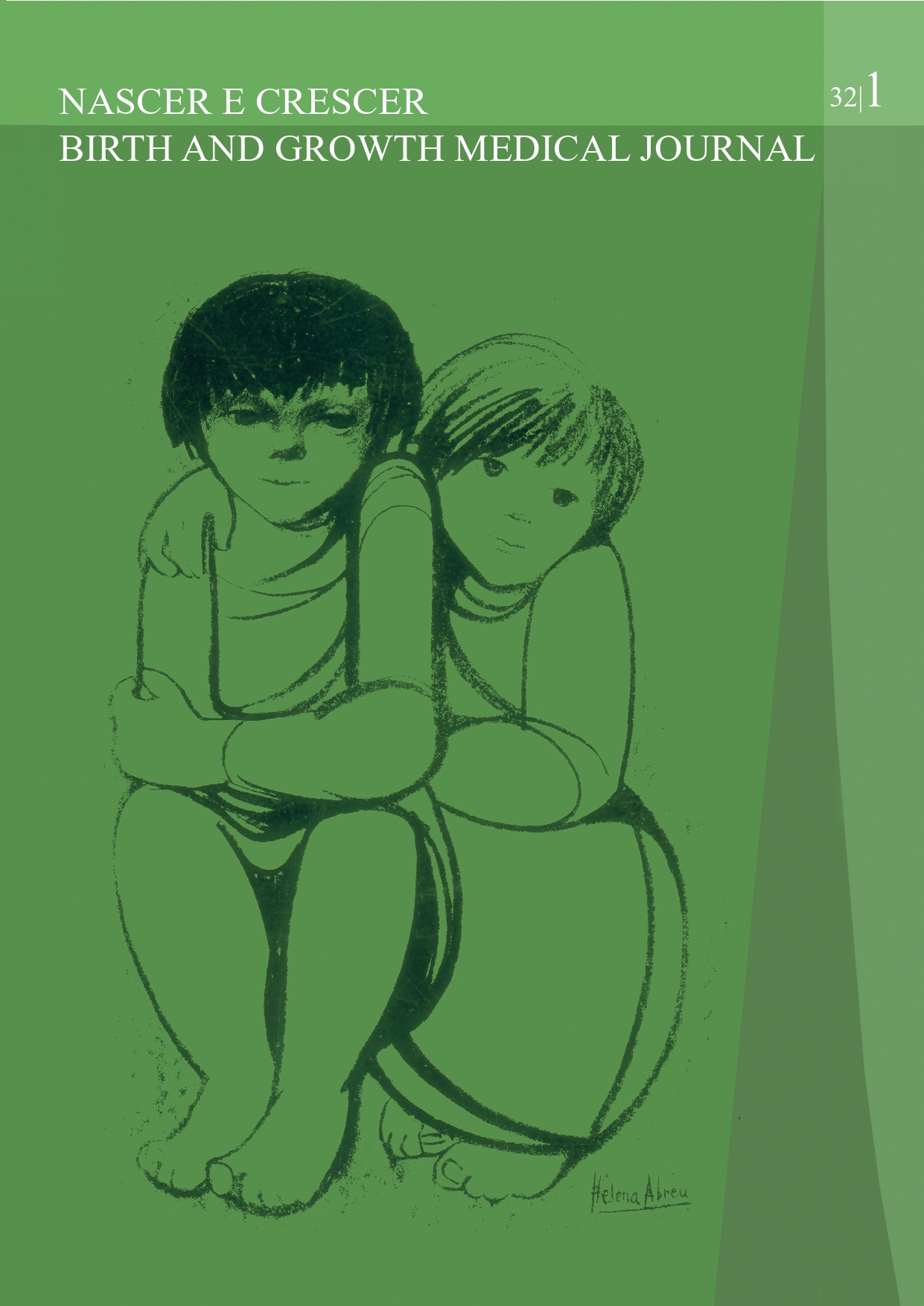Sickle cell disease: Clinical and sociodemographic characteristics of children under five years in a Portuguese hospital
DOI:
https://doi.org/10.25753/BirthGrowthMJ.v32.i1.25410Keywords:
anemia, hematology, pediatric age, sickle cell diseaseAbstract
Introduction: The global incidence of sickle cell disease (SCD) is approximately 300.000 births per year, and the condition is associated with significant morbidity and mortality in pediatric age. This study aimed to describe the sociodemographic and clinical characteristics of children up to five years of age with SCD in a Portuguese center.
Methods: This was a descriptive retrospective study of children aged until five years with a diagnosis of SCD and hematologic follow-up in a level II Portuguese hospital between January 2010 and December 2019.
Results: Eighty-six patients were included, mostly of African descendent and homozygotic for hemoglobin S. The median age at diagnosis was five months, obtained through neonatal screening in 44.2%, in the context of hospitalization in 34.9%, and in ambulatory observation in 17.4% of patients. A total of 96.5% of cases were compliant with the Portuguese National Vaccination (PNV) Program, and 48.8% completed the extra-PNV scheme. All patients were under folic acid supplementation, 98% were under amoxicillin prophylaxis, and 6.9% were under hydroxycarbamide. Transcranial Doppler was conducted in 68.6% of patients and was altered in only one, echocardiogram was performed in 72.1% of patients and showed left ventricle dilatation in 21%, and overnight polysomnography was performed in 24.4% of patients and revealed obstructive sleep apnea in 95.2%. Each child had an average of four hospitalizations during the study period, with the most common diagnosis being vaso-occlusive crisis in 38.3%, followed by fever of unknow origin in 23.4%, upper airway infection in 17.8%, bacterial pneumonia and splenic sequestration in 10.7% each, and worsening anemia in 9.5%.
Discussion: Given the chronicity of SCD and the multiplicity of associated comorbidities, it is essential to reinforce the importance of multidisciplinary follow-up and family engagement in treatment.
Downloads
References
McCavit TL. Sickle Cell Disease. Pediatrics in Review 2012; 33(5) 195-206. Doi: doi: https://doi.org/10.1542/pir.33-5-195.
Piccone CM. Sickle Cell Disease. In: Florin TA, Ludwig S, Aronson PL, Werner HD. Netter’s Pediatrics. Philadelphia; 2011. p.326-30.
McMahon C. Sickle Cell Disease. In: Arceci RJ, Hann IM, Smith OP. Pediatric Hematology, 3rd Edition. United Kingdom; 2006. p.213-30.
DeBaun MR, Frei-Jones MJ, Vichinsky EP. Hemoglobinopathies. In: Kliegman RM, Stanton BF, St Geme III JW, Schor NF. Nelson Textbook of Pediatrics, 20th Edition. Canada; 2016. p.2336-53.
Houwing ME, de Pagter PJ, van Beers EJ, Biemond BJ, Rettenbacher E, Rijneveld AW, et al. Sickle cell disease: Clinical presentation and management of a global health challenge. Blood Rev. 2019;37:100580. Doi: https://doi.org/110.1016/j.blre.2019.05.004.
Williams TN. Sickle Cell Disease in Sub-Saharan Africa. Hematol Oncol Clin North Am. 2016;30(2):343-58. Doi: https://doi.org/110.1016/j.hoc.2015.11.005.
Ogu UO, Billett HH. Comorbidities in sickle cell disease: Adult providers needed! Indian J Med Res. 2018;147(6):527-9. Doi: https://doi.org/110.4103/ijmr.IJMR_1019_18.
Rosen CL, Debaun MR, Strunk RC, Redline S, Seicean S, Craven DI, et al. Obstructive sleep apnea and sickle cell anemia. Pediatrics. 2014;134(2):273-81. Doi: https://doi.org/110.1542/peds.2013-4223.
PORDATA, Base de dados Portugal contemporâneo. 2018 Database. Fundação Francisco Manuel dos Santos. [Retrieved May 2020]. Available at: https://www.pordata.pt/Home.
Diagnóstico Social do Concelho de Sintra Dinâmicas Demográficas e Habitacionais, Câmara Municipal de Sintra - Departamento de Solidariedade e Inovação Social. Março 2014. [Retrieved June 2020]. Available at: https://cm-sintra.pt/phocadownload/PDF/acao_social/diagnostico-scs.pdf.
Amadora XXI, DIG - divisão de informação geográfica, 2011. [Retrieved June 2020]. Available at: http://www.cm-amadora.pt/images/TERRITORIO/INFORMACAO_GEOGRAFICA/PDF/ESTATISTICAS/Populacao_2011.pdf.
Infanti LM, Elder JJ, Franco K, Simms S, Statler VA, Raj A. Immunization Adherence in Children With Sickle Cell Disease: A Single-Institution Experience. J Pediatr Pharmacol Ther. 2020;25(1):39-46. Doi: https://doi.org/110.5863/1551-6776-25.1.39.
Qureshi A, Kaya B, Pancham S, Keenan R, Anderson J, Akanni M, et al. British Society for Haematology. Guidelines for the use of hydroxycarbamide in children and adults with sickle cell disease: A British Society for Haematology Guideline. Br J Haematol. 2018;181(4):460-75. Doi: https://doi.org/110.1111/bjh.15235.
Allen KY, Jones S, Jackson T, DeCost G, Stephens P, Hanna BD, et al. Echocardiographic Screening of Cardiovascular Status in Pediatric Sickle Cell Disease. Pediatr Cardiol 2019; 40: 1670-8. Doi: https://doi.org/110.1007/s00246-019-02202-3.
Mascarenhas MI, Loureiro HC, Ferreira T, Dias A. Sleep pathology characterization in sickle cell disease: case-control study. Pediatr Pulmonol. 2015;50(4):396-401. Doi: https://doi.org/110.1002/ppul.23074.
Downloads
Published
How to Cite
Issue
Section
License
Copyright (c) 2023 Inês Mendes, Adriana Costa, Joana Lage, Bernardo Monteiro, Teresa Ferreira, Helena Loureiro

This work is licensed under a Creative Commons Attribution-NonCommercial 4.0 International License.
Copyright and Authors' Rights
All articles published in Nascer e Crescer - Birth and Growth Medical Journal are Open Access and comply with the requirements of funding agencies or academic institutions. For use by third parties, Nascer e Crescer - Birth and Growth Medical Journal adheres to the terms of the Creative Commons License "Attribution - Non-Commercial Use (CC-BY-NC)".
It is the author's responsibility to obtain permission to reproduce figures, tables, etc. from other publications.
Authors must submit a Conflict of Interest statement and an Authorship Form with the submission of the article. An e-mail will be sent to the corresponding author confirming receipt of the manuscript.
Authors are permitted to make their articles available in repositories at their home institutions, provided that they always indicate where the articles were published and adhere to the terms of the Creative Commons license.


